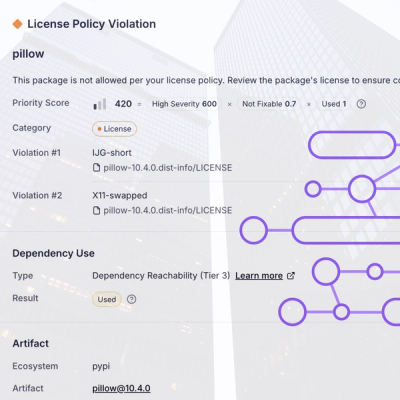
Research
/Security News
Critical Vulnerability in NestJS Devtools: Localhost RCE via Sandbox Escape
A flawed sandbox in @nestjs/devtools-integration lets attackers run code on your machine via CSRF, leading to full Remote Code Execution (RCE).
This library and repository was previously located at pipermerriam/py-trie. It was transferred to the Ethereum foundation GitHub in November 2017 and renamed to
py-trie.
Read more in the documentation below.
View the change log.
python -m pip install trie
If you would like to hack on py-trie, please check out the Snake Charmers Tactical Manual for information on how we do:
We use pre-commit to maintain consistent code style. Once
installed, it will run automatically with every commit. You can also run it manually
with make lint. If you need to make a commit that skips the pre-commit checks, you
can do so with git commit --no-verify.
You can set up your dev environment with:
git clone git@github.com:ethereum/py-trie.git
cd py-trie
virtualenv -p python3 venv
. venv/bin/activate
python -m pip install -e ".[dev]"
pre-commit install
You can run the tests with:
git submodule update --init --recursive
pytest tests
To release a new version:
make release bump=$$VERSION_PART_TO_BUMP$$
The version format for this repo is {major}.{minor}.{patch} for stable, and
{major}.{minor}.{patch}-{stage}.{devnum} for unstable (stage can be alpha or beta).
To issue the next version in line, specify which part to bump,
like make release bump=minor or make release bump=devnum. This is typically done from the
main branch, except when releasing a beta (in which case the beta is released from main,
and the previous stable branch is released from said branch).
If you are in a beta version, make release bump=stage will switch to a stable.
To issue an unstable version when the current version is stable, specify the
new version explicitly, like make release bump="--new-version 4.0.0-alpha.1 devnum"
>>> from trie import HexaryTrie
>>> t = HexaryTrie(db={})
>>> t.root_hash
b'V\xe8\x1f\x17\x1b\xccU\xa6\xff\x83E\xe6\x92\xc0\xf8n[H\xe0\x1b\x99l\xad\xc0\x01b/\xb5\xe3c\xb4!'
>>> t.set(b'my-key', b'some-value')
>>> t.get(b'my-key')
b'some-value'
>>> t.exists(b'another-key')
False
>>> t.set(b'another-key', b'another-value')
>>> t.exists(b'another-key')
True
>>> t.delete(b'another-key')
>>> t.exists(b'another-key')
False
You can also use it like a dictionary.
>>> from trie import HexaryTrie
>>> t = HexaryTrie(db={})
>>> t.root_hash
b'V\xe8\x1f\x17\x1b\xccU\xa6\xff\x83E\xe6\x92\xc0\xf8n[H\xe0\x1b\x99l\xad\xc0\x01b/\xb5\xe3c\xb4!'
>>> t[b'my-key'] = b'some-value'
>>> t[b'my-key']
b'some-value'
>>> b'another-key' in t
False
>>> t[b'another-key'] = b'another-value'
>>> b'another-key' in t
True
>>> del t[b'another-key']
>>> b'another-key' in t
False
>>> from trie import HexaryTrie
>>> t = HexaryTrie(db={})
>>> t.root_hash
b'V\xe8\x1f\x17\x1b\xccU\xa6\xff\x83E\xe6\x92\xc0\xf8n[H\xe0\x1b\x99l\xad\xc0\x01b/\xb5\xe3c\xb4!'
>>> t[b'my-key'] = b'some-value'
>>> t[b'my-other-key'] = b'another-value'
# Look at the root node:
>>> root_node = t.traverse(())
>>> root_node
HexaryTrieNode(sub_segments=((0x6, 0xd, 0x7, 0x9, 0x2, 0xd, 0x6),), value=b'', suffix=(), raw=[b'\x16\xd7\x92\xd6', b'\xb4q\xb8h\xec\x1c\xe1\xf4\\\x88\xda\xb4\xc1\xc2n\xbaw\xd0\x9c\xf1\xacV\xb4Dk\xa7\xe6\xd7qf\xc2\x82'])
# the root node is an extension down, because the first 7 nibbles are the same between the two keys
# Let's walk down to the child of that extension
>>> prefix6d792d6 = t.traverse(root_node.sub_segments[0])
>>> prefix6d792d6
HexaryTrieNode(sub_segments=((0xb,), (0xf,)), value=b'', suffix=(), raw=[b'', b'', b'', b'', b'', b'', b'', b'', b'', b'', b'', [b' ey', b'some-value'], b'', b'', b'', [b' ther-key', b'another-value'], b''])
# A branch node separates the second nibbles of b'k' and b'o': 0xb and 0xf
# Notice the position of the children in the 11th and 15th index
# Another way to get there without loading the root node from the database is using traverse_from:
>>> assert t.traverse_from(root_node, root_node.sub_segments[0]) == prefix6d792d6
# Embedded nodes can be traversed to the same way as nodes stored in the database:
>>> t.traverse(root_node.sub_segments[0] + (0xb,))
HexaryTrieNode(sub_segments=(), value=b'some-value', suffix=(0x6, 0x5, 0x7, 0x9), raw=[b' ey', b'some-value'])
# This leaf node includes the suffix (the rest of the key, in nibbles, that haven't been traversed,
# just b'ey': 0x6579
To walk through the full trie (for example, to verify that all node bodies are present in the database), use HexaryTrieFog and the traversal API above.
For example:
>>> from trie import HexaryTrie
>>> t = HexaryTrie(db={})
>>> t.root_hash
b'V\xe8\x1f\x17\x1b\xccU\xa6\xff\x83E\xe6\x92\xc0\xf8n[H\xe0\x1b\x99l\xad\xc0\x01b/\xb5\xe3c\xb4!'
>>> t[b'my-key'] = b'some-value'
>>> t[b'my-other-key'] = b'another-value'
>>> t[b'your-key'] = b'your-value'
>>> t[b'your-other-key'] = b'your-other-value'
>>> t.root_hash
b'\xf8\xdd\xe4\x0f\xaa\xf4P7\xfa$\xfde>\xec\xb4i\x00N\xa3)\xcf\xef\x80\xc4YU\xe8\xe7\xbf\xa89\xd5'
# Initialize a fog object to track unexplored prefixes in a trie walk
>>> from trie.fog import HexaryTrieFog
>>> empty_fog = HexaryTrieFog()
# At the beginning, the unexplored prefix is (), which means that none of the trie has been explored
>>> prefix = empty_fog.nearest_unknown()
()
# So we start by exploring the node at prefix () -- which is the root node:
>>> node = t.traverse(prefix)
HexaryTrieNode(sub_segments=((0x6,), (0x7,)), value=b'', suffix=(), raw=[b'', b'', b'', b'', b'', b'', b"\x03\xd2vk\x85\xce\xe1\xa8\xdb'F\x8c\xe5\x15\xc6\n+M:th\xa1\\\xb13\xcc\xe8\xd0\x1d\xa7\xa8U", b"\x1b\x8d'\xb3\x99(yX\xaa\x96C!\xba'X \xbb|\xa6,\xb5V!\xd3\x1a\x05\xe5\xbf\x02\xa3fR", b'', b'', b'', b'', b'', b'', b'', b'', b''])
# and mark the root as explored, while defining the unexplored children:
>>> level1fog = empty_fog.explore(prefix, node.sub_segments)
# Now the unexplored prefixes are the keys starting with the four bits 6 and the four bits 7.
# All other keys are known to not exist (and so have been explored)
>>> level1fog
HexaryTrieFog<SortedSet([(0x6,), (0x7,)])>
# So we continue exploring. The fog helps choose which prefix to explore next:
>>> level1fog.nearest_unknown()
(0x6,)
# We can also look for the nearest unknown key to a particular target
>>> prefix = level1fog.nearest_unknown((8, 1))
(0x7,)
>>> node7 = node.traverse(prefix)
HexaryTrieNode(sub_segments=((0x9, 0x6, 0xf, 0x7, 0x5, 0x7, 0x2, 0x2, 0xd, 0x6),), value=b'', suffix=(), raw=[b'\x00\x96\xf7W"\xd6', b"\xe2\xe2oN\xe1\xf8\xda\xc1\x8c\x03\x92'\x93\x805\xad-\xef\x07_\x0ePV\x1f\xb5/lVZ\xc6\xc1\xf9"])
# We found an extension node, and mark it in the fog
# For simpliticy, we'll start clobbering the `fog` variable
>>> fog = level1fog.explore(prefix, node7.sub_segments)
HexaryTrieFog<SortedSet([(0x6,), (0x7, 0x9, 0x6, 0xf, 0x7, 0x5, 0x7, 0x2, 0x2, 0xd, 0x6)])>
# Let's explore the next branch node and see what's left
>>> prefix = fog.nearest_unknown((7,))
(0x7, 0x9, 0x6, 0xf, 0x7, 0x5, 0x7, 0x2, 0x2, 0xd, 0x6)
>>> node796f75722d6 = t.traverse(prefix)
HexaryTrieNode(sub_segments=((0xb,), (0xf,)), value=b'', suffix=(), raw=[b'', b'', b'', b'', b'', b'', b'', b'', b'', b'', b'', [b' ey', b'your-value'], b'', b'', b'', [b' ther-key', b'your-other-value'], b''])
# Notice that the branch node inlines the values, but the fog and annotated node ignore them for now
>>> fog = fog.explore(prefix, node796f75722d6.sub_segments)
HexaryTrieFog<SortedSet([(0x6,), (0x7, 0x9, 0x6, 0xf, 0x7, 0x5, 0x7, 0x2, 0x2, 0xd, 0x6, 0xb), (0x7, 0x9, 0x6, 0xf, 0x7, 0x5, 0x7, 0x2, 0x2, 0xd, 0x6, 0xf)])>
# Index keys may not matter for some use cases, so we can leave them out
# entirely, like nearest_unknown().
# There's one more feature to consider: we can look directionally to the right
# of an index for the nearest prefix.
>>> prefix = fog.nearest_right((0x7, 0x9, 0x6, 0xf, 0x7, 0x5, 0x7, 0x2, 0x2, 0xd, 0x6, 0xc))
(0x7, 0x9, 0x6, 0xf, 0x7, 0x5, 0x7, 0x2, 0x2, 0xd, 0x6, 0xf)
# That same index key would give a closer prefix to the left if direction didn't matter
# (See the difference in the very last nibble)
>>> fog.nearest_unknown((0x7, 0x9, 0x6, 0xf, 0x7, 0x5, 0x7, 0x2, 0x2, 0xd, 0x6, 0xc))
(0x7, 0x9, 0x6, 0xf, 0x7, 0x5, 0x7, 0x2, 0x2, 0xd, 0x6, 0xb)
# So we traverse to this last embedded leaf node at `prefix`
>>> a_leaf_node = t.traverse(prefix)
HexaryTrieNode(sub_segments=(), value=b'your-other-value', suffix=(0x7, 0x4, 0x6, 0x8, 0x6, 0x5, 0x7, 0x2, 0x2, 0xd, 0x6, 0xb, 0x6, 0x5, 0x7, 0x9), raw=[b' ther-key', b'your-other-value'])
# we mark the prefix as fully explored like so:
>>> fog = fog.explore(prefix, a_leaf_node.sub_segments)
HexaryTrieFog<SortedSet([(0x6,), (0x7, 0x9, 0x6, 0xf, 0x7, 0x5, 0x7, 0x2, 0x2, 0xd, 0x6, 0xb)])>
# Notice that sub_segments was empty, and the prefix has disappeared from our list of unexplored prefixes
# So far we have dealt with an un-changing trie, but what if it is
# modified while we are working on it?
>>> del t[b'your-other-key']
>>> t[b'your-key-rebranched'] = b'your-value'
>>> t.root_hash
b'"\xc0\xcaQ\xa7X\x08E\xb5"A\xde\xbfY\xeb"XY\xb1O\x034=\x04\x06\xa9li\xd8\x92\xadP'
# The unexplored prefixes we have before might not exist anymore. They might:
# 1. have been deleted entirely, in which case, we will get a blank node, and need no special treatment
# 2. lead us into the middle of a leaf or extension node, which makes things tricky
>>> prefix = fog.nearest_unknown((8,))
(0x7, 0x9, 0x6, 0xf, 0x7, 0x5, 0x7, 0x2, 0x2, 0xd, 0x6, 0xb)
>>> t.traverse(prefix)
TraversedPartialPath: Could not traverse through HexaryTrieNode(sub_segments=((0x9, 0x6, 0xf, 0x7, 0x5, 0x7, 0x2, 0x2, 0xd, 0x6, 0xb, 0x6, 0x5, 0x7, 0x9),), value=b'', suffix=(), raw=[b'\x19our-key', b'f\xbe\x88\x8f#\xd5\x15-8\xc0\x1f\xfb\xf7\x8b=\x98\x86 \xec\xdeK\x07\xc8\xbf\xa7\x93\xfa\x9e\xc1\x89@\x00']) at (0x7,), only partially traversed with: (0x9, 0x6, 0xf, 0x7, 0x5, 0x7, 0x2, 0x2, 0xd, 0x6, 0xb)
# Let's drill into what this means:
# - We fully traversed to a node at prefix (7,)
# - We tried to traverse into the rest of the prefix
# - We only got part-way through the extension node: (0x9, 0x6, 0xf, 0x7, 0x5, 0x7, 0x2, 0x2, 0xd, 0x6, 0xb)
# - The extension node full sub-segment is actually: (0x9, 0x6, 0xf, 0x7, 0x5, 0x7, 0x2, 0x2, 0xd, 0x6, 0xb, 0x6, 0x5, 0x7, 0x9)
# So what do we do about it? Catch the exception, and explore with the fog slightly differently
>>> from trie.exceptions import TraversedPartialPath
>>> last_exception = None
>>> try:
t.traverse(prefix)
except TraversedPartialPath as exc:
last_exception = exc
# We can now continue exploring the children of the extension node, by using an attribute on the exception:
>>> sub_segments = last_exception.simulated_node.sub_segments
((0x6, 0x5, 0x7, 0x9),)
# Note that this sub-segment now carries us the rest of the way to the child
# of the node that we only partially traversed into.
# This "simulated_node" is created by slicing the extension node in two: the
# first extension node having the path that we (partially) traversed, and the second
# extension node being the child of that parent, which continues on to point to
# the child of the original extension.
# If the exception is raised on a leaf node, then the leaf node is sliced into
# an extension and another shorter leaf node.
>>> fog = fog.explore(prefix, sub_segments)
HexaryTrieFog<SortedSet([(0x6,), (0x7, 0x9, 0x6, 0xf, 0x7, 0x5, 0x7, 0x2, 0x2, 0xd, 0x6, 0xb, 0x6, 0x5, 0x7, 0x9)])>
# So now we can pick up where we left off, traversing to the child of the extension node, and so on.
>>> prefix = fog.nearest_unknown((8,))
(0x7, 0x9, 0x6, 0xf, 0x7, 0x5, 0x7, 0x2, 0x2, 0xd, 0x6, 0xb, 0x6, 0x5, 0x7, 0x9)
# The following will not raise a TraversedPartialPath exception, because we know that
# a node was at the path, and the trie hasn't changed:
>>> t.traverse(prefix)
HexaryTrieNode(sub_segments=((0x2,),), value=b'your-value', suffix=(), raw=[b'', b'', [b'=rebranched', b'your-value'], b'', b'', b'', b'', b'', b'', b'', b'', b'', b'', b'', b'', b'', b'your-value'])
# etc...
Note: traverse() will access the database for every node from the root to the target node. If navigating a large trie, consider using TrieFrontierCache and HexaryTrie.traverse_from() to minimize database lookups. See the tests in tests/test_hexary_trie_walk.py for some examples.
Note: One drawback of Binary Trie is that one key can not be the prefix of another key. For example,
if you already set the value value1 with key key1, you can not set another value with key key or key11
and the like.
>>> from trie import BinaryTrie
>>> from trie.branches import (
>>> check_if_branch_exist,
>>> get_branch,
>>> if_branch_valid,
>>> get_witness_for_key_prefix,
>>> )
>>> t = BinaryTrie(db={})
>>> t.root_hash
b"\xc5\xd2F\x01\x86\xf7#<\x92~}\xb2\xdc\xc7\x03\xc0\xe5\x00\xb6S\xca\x82';{\xfa\xd8\x04]\x85\xa4p"
>>> t.set(b'key1', b'value1')
>>> t.set(b'key2', b'value2')
Now Trie looks like this:
root ---> (kvnode, *common key prefix*)
|
|
|
(branchnode)
/ \
/ \
/ \
(kvnode, *remain kepath*)(kvnode, *remain kepath*)
| |
| |
| |
(leafnode, b'value1') (leafnode, b'value2')
>>> # check_if_branch_exist function
>>> check_if_branch_exist(t.db, t.root_hash, b'key')
True
>>> check_if_branch_exist(t.db, t.root_hash, b'key1')
True
>>> check_if_branch_exist(t.db, t.root_hash, b'ken')
False
>>> check_if_branch_exist(t.db, t.root_hash, b'key123')
False
>>> # get_branch function
>>> get_branch(t.db, t.root_hash, b'key1')
(b'\x00\x82\x1a\xd9^L|38J\xed\xf31S\xb2\x97A\x8dy\x91RJ\x92\xf5ZC\xb4\x99T&;!\x9f\xa9!\xa2\xfe;', b"\x01*\xaccxH\x89\x08}\x93|\xda\xb9\r\x9b\x82\x8b\xb2Y\xbc\x10\xb9\x88\xf40\xef\xed\x8b'\x13\xbc\xa5\xccYGb\xc2\x8db\x88lPs@)\x86v\xd7B\xf7\xd3X\x93\xc9\xf0\xfd\xae\xe0`j#\x0b\xca;\xf8", b'\x00\x11\x8aEL3\x839E\xbd\xc4G\xd1xj\x0fxWu\xcb\xf6\xf3\xf2\x8e7!M\xca\x1c/\xd7\x7f\xed\xc6', b'\x02value1')
Node started with b'\x00', b'\x01' and b'\x02' are kvnode, branchnode and leafnode respectively.
>>> get_branch(t.db, t.root_hash, b'key')
(b'\x00\x82\x1a\xd9^L|38J\xed\xf31S\xb2\x97A\x8dy\x91RJ\x92\xf5ZC\xb4\x99T&;!\x9f\xa9!\xa2\xfe;',)
>>> get_branch(t.db, t.root_hash, b'key123') # InvalidKeyError
>>> get_branch(t.db, t.root_hash, b'key5') # there is still branch for non-exist key
(b'\x00\x82\x1a\xd9^L|38J\xed\xf31S\xb2\x97A\x8dy\x91RJ\x92\xf5ZC\xb4\x99T&;!\x9f\xa9!\xa2\xfe;',)
>>> # if_branch_valid function
>>> v = t.get(b'key1')
>>> b = get_branch(t.db, t.root_hash, b'key1')
>>> if_branch_valid(b, t.root_hash, b'key1', v)
True
>>> v = t.get(b'key5') # v should be None
>>> b = get_branch(t.db, t.root_hash, b'key5')
>>> if_branch_valid(b, t.root_hash, b'key5', v)
True
>>> v = t.get(b'key1')
>>> b = get_branch(t.db, t.root_hash, b'key2')
>>> if_branch_valid(b, t.root_hash, b'key1', v) # KeyError
>>> if_branch_valid([], t.root_hash, b'key1', v) # AssertionError
>>> # get_witness_for_key_prefix function
>>> get_witness_for_key_prefix(t.db, t.root_hash, b'key1') # equivalent to `get_branch(t.db, t.root_hash, b'key1')`
(b'\x00\x82\x1a\xd9^L|38J\xed\xf31S\xb2\x97A\x8dy\x91RJ\x92\xf5ZC\xb4\x99T&;!\x9f\xa9!\xa2\xfe;', b"\x01*\xaccxH\x89\x08}\x93|\xda\xb9\r\x9b\x82\x8b\xb2Y\xbc\x10\xb9\x88\xf40\xef\xed\x8b'\x13\xbc\xa5\xccYGb\xc2\x8db\x88lPs@)\x86v\xd7B\xf7\xd3X\x93\xc9\xf0\xfd\xae\xe0`j#\x0b\xca;\xf8", b'\x00\x11\x8aEL3\x839E\xbd\xc4G\xd1xj\x0fxWu\xcb\xf6\xf3\xf2\x8e7!M\xca\x1c/\xd7\x7f\xed\xc6', b'\x02value1')
>>> get_witness_for_key_prefix(t.db, t.root_hash, b'key') # this will include additional nodes of b'key2'
(b'\x00\x82\x1a\xd9^L|38J\xed\xf31S\xb2\x97A\x8dy\x91RJ\x92\xf5ZC\xb4\x99T&;!\x9f\xa9!\xa2\xfe;', b"\x01*\xaccxH\x89\x08}\x93|\xda\xb9\r\x9b\x82\x8b\xb2Y\xbc\x10\xb9\x88\xf40\xef\xed\x8b'\x13\xbc\xa5\xccYGb\xc2\x8db\x88lPs@)\x86v\xd7B\xf7\xd3X\x93\xc9\xf0\xfd\xae\xe0`j#\x0b\xca;\xf8", b'\x00\x11\x8aEL3\x839E\xbd\xc4G\xd1xj\x0fxWu\xcb\xf6\xf3\xf2\x8e7!M\xca\x1c/\xd7\x7f\xed\xc6', b'\x02value1', b'\x00\x10O\xa9\x0b\x1c!_`<\xb5^\x98D\x89\x17\x148\xac\xda&\xb3P\xf6\x06[\x1b9\xc09\xbas\x85\xf5', b'\x02value2')
>>> get_witness_for_key_prefix(t.db, t.root_hash, b'') # this will return the whole trie
FAQs
Python implementation of the Ethereum Trie structure
We found that trie demonstrated a healthy version release cadence and project activity because the last version was released less than a year ago. It has 6 open source maintainers collaborating on the project.
Did you know?

Socket for GitHub automatically highlights issues in each pull request and monitors the health of all your open source dependencies. Discover the contents of your packages and block harmful activity before you install or update your dependencies.

Research
/Security News
A flawed sandbox in @nestjs/devtools-integration lets attackers run code on your machine via CSRF, leading to full Remote Code Execution (RCE).

Product
Customize license detection with Socket’s new license overlays: gain control, reduce noise, and handle edge cases with precision.

Product
Socket now supports Rust and Cargo, offering package search for all users and experimental SBOM generation for enterprise projects.